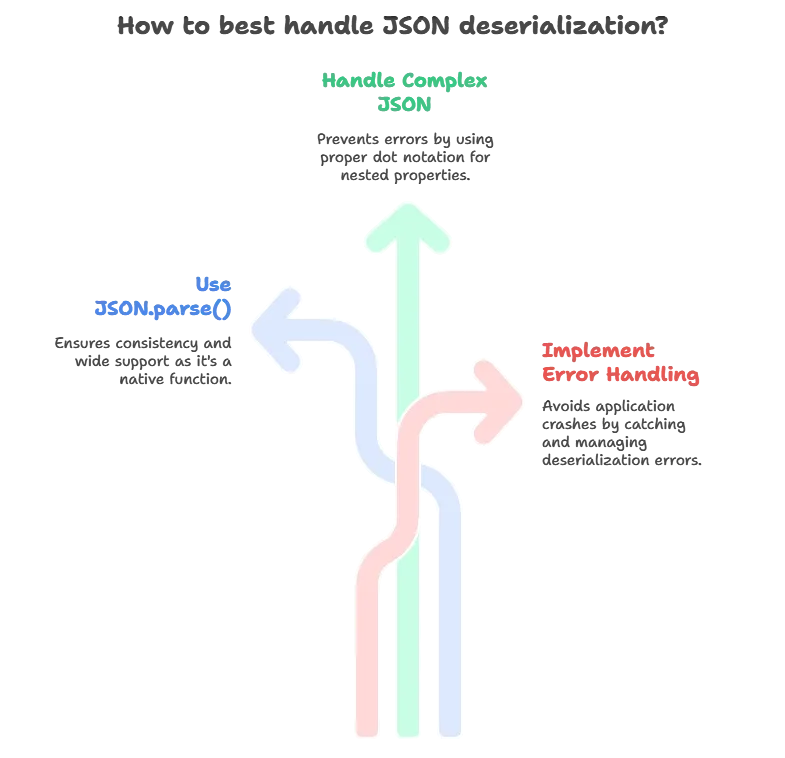Deserializing JSON with jQuery
JSON (JavaScript Object Notation) is a lightweight data format commonly used to exchange data between a client and server. jQuery provides built-in functions to handle JSON data, including deserialization, which involves converting JSON data into JavaScript objects that can be manipulated easily in your web applications.
Introduction to JSON and Deserialization
What is JSON?
JSON (JavaScript Object Notation) is a simple, text-based format used to represent structured data. It is widely used in web development for exchanging data between a client and server.
Example of JSON Data:
{
"name": "John Doe",
"age": 30,
"email": "johndoe@example.com",
"address": {
"street": "123 Main St",
"city": "Springfield"
}
}
This JSON represents a person with attributes like name, age, email, and an address object.
Why Deserialization is Important?
Deserialization is the process of converting JSON strings into JavaScript objects. This is necessary because JSON data is often received as a string, and you need to convert it into an object to work with it in your code.
Basic Concepts
What is Deserialization?
Deserialization is the process of converting a JSON string into a JavaScript object. After deserialization, the data can be accessed like any other object in JavaScript, allowing developers to manipulate it, display it on the web page, or send it to another service.
Why Use jQuery for Deserialization?
jQuery simplifies the process of working with JSON, especially when dealing with asynchronous operations like AJAX calls. With built-in functions for handling JSON, jQuery makes it easier to retrieve, parse, and display data from external sources.
Deserializing JSON in jQuery
jQuery provides different methods to deserialize JSON data. Let’s look at two main ways of doing this.
Using $.parseJSON()
The $.parseJSON() method is a utility provided by jQuery to parse JSON strings into JavaScript objects.
Syntax:
$.parseJSON(jsonString);
Example:
<script type="litespeed/javascript">$(document).ready(function(){var jsonString='{"name": "John Doe", "age": 30, "email": "johndoe@example.com"}';var userObject=$.parseJSON(jsonString);console.log(userObject)})</script>
Explanation:
- Code: In this example, the JSON string is deserialized into a JavaScript object using
$.parseJSON(). - Output: The console will display the following object:
{ name: "John Doe", age: 30, email: "johndoe@example.com" }
Using JSON.parse()
The JSON.parse() method is a standard JavaScript function that is often preferred over $.parseJSON() as it’s part of the native JavaScript API and widely supported.
Syntax:
JSON.parse(jsonString);
Example:
<script type="litespeed/javascript">$(document).ready(function(){var jsonString='{"name": "Jane Doe", "age": 25, "email": "janedoe@example.com"}';var userObject=JSON.parse(jsonString);console.log(userObject)})</script>
Explanation:
- Code: Here,
JSON.parse()converts the JSON string into a JavaScript object. - Output: The console will display:
{ name: "Jane Doe", age: 25, email: "janedoe@example.com" }
Working with JSON Data
After deserialization, you can access and manipulate the JSON data just like any JavaScript object.
Accessing JSON Data After Deserialization
Once the JSON string is deserialized, its data can be accessed using dot notation or bracket notation.
Example:
<script type="litespeed/javascript">$(document).ready(function(){var jsonString='{"name": "John Doe", "age": 30, "email": "johndoe@example.com"}';var userObject=JSON.parse(jsonString);console.log(userObject.name);console.log(userObject.age)})</script>
Looping Through JSON Data
When dealing with arrays in JSON, you can use a loop to iterate over the data.
Example:
<script type="litespeed/javascript">$(document).ready(function(){var jsonString='[{"name": "John"}, {"name": "Jane"}, {"name": "Bob"}]';var userArray=JSON.parse(jsonString);$.each(userArray,function(index,user){console.log(user.name)})})</script>
Explanation:
- Code: The
$.each()method is used to loop through the array of objects. - Output: The console will display:
John
Jane
Bob
Advanced Techniques
Handling Complex JSON Structures
When working with deeply nested JSON objects or arrays, you need to access the data carefully using proper dot notation.
Example:
<script type="litespeed/javascript">$(document).ready(function(){var jsonString='{"name": "John Doe", "address": {"street": "123 Main St", "city": "Springfield"}}';var userObject=JSON.parse(jsonString);console.log(userObject.address.street)})</script>
Error Handling in Deserialization
When deserializing JSON, it’s important to handle potential errors, such as invalid JSON syntax.
Example:
<script type="litespeed/javascript">$(document).ready(function(){var jsonString='{"name": "John Doe", "age": 30';try{var userObject=JSON.parse(jsonString);console.log(userObject)}catch(error){console.error("Invalid JSON:",error)}})</script>
Explanation:
- Code: A
try-catchblock is used to catch any errors in the JSON parsing process. - Output: The console will display an error message indicating the invalid JSON structure.
Practical Examples
Deserializing JSON from a Server Response
Often, JSON data is received as a response from a server, and you need to deserialize it for further use.
Example:
<script type="litespeed/javascript">$(document).ready(function(){$.ajax({url:"user.json",method:"GET",success:function(response){var userObject=JSON.parse(response);console.log(userObject.name)}})})</script>
Explanation:
- Code: The JSON response from the server is deserialized using
JSON.parse(). - Output: The console will display the name from the server’s JSON response.
Dynamic Data Handling with JSON
You can dynamically create and deserialize JSON data for various uses.
Example:
<script type="litespeed/javascript">$(document).ready(function(){var jsonData=JSON.stringify({name:"Alice",age:28});var deserializedData=JSON.parse(jsonData);console.log(deserializedData.name)})</script>
Common Mistakes and How to Avoid Them
- Mistake: Using invalid JSON strings.
- Solution: Always ensure that the JSON string is properly formatted and enclosed in double quotes.
- Mistake: Forgetting to handle errors during deserialization.
- Solution: Use
try-catchblocks to catch any parsing errors.
- Solution: Use
Best Practices
- Use
JSON.parse()for Consistency: As it is a native JavaScript function,JSON.parse()is widely supported and recommended for deserialization. - Handle Complex JSON with Care: Always use proper dot notation to access deeply nested properties.
- Implement Error Handling: Always include error handling when deserializing data to avoid breaking your application.

Deserializing JSON with jQuery is an essential technique for any web developer working with dynamic data from servers. By using methods like $.parseJSON() or the native JSON.parse(), you can easily convert JSON. Happy Coding!❤️
